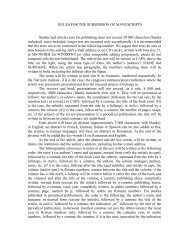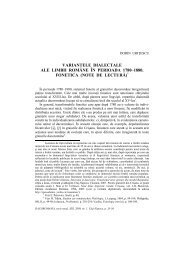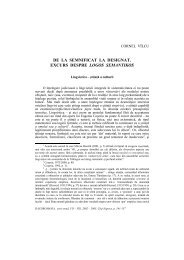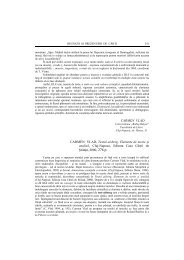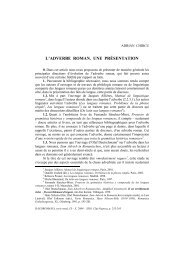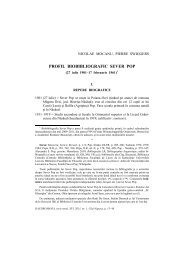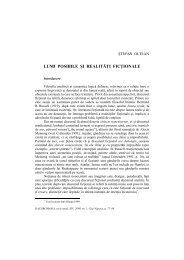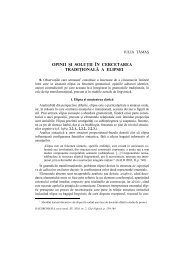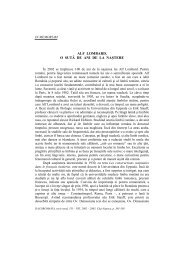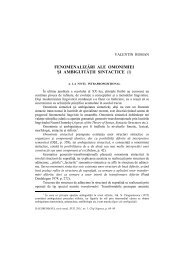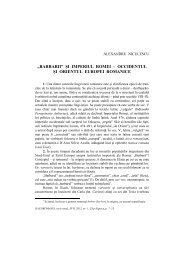gender in arabic. from a language planning ... - Dacoromania
gender in arabic. from a language planning ... - Dacoromania
gender in arabic. from a language planning ... - Dacoromania
Create successful ePaper yourself
Turn your PDF publications into a flip-book with our unique Google optimized e-Paper software.
FAWWAZ AL-ABED AL-HAQ,REEMA SALAH AL-HAYEK *GENDER IN ARABIC. FROM A LANGUAGEPLANNING PERSPECTIVEINTRODUCTION: LANGUAGE PLANNINGLanguage Plann<strong>in</strong>g refers to the organized pursuit of solutions to <strong>language</strong>problems, typically at the national level (Jernudd, Das Gupta 1971). The goal of<strong>language</strong> plann<strong>in</strong>g is to offer solutions to l<strong>in</strong>guistic and non-l<strong>in</strong>guistic problems <strong>in</strong>both developed and develop<strong>in</strong>g countries. These problems are related to the status,corpus, and acquisition of <strong>language</strong>.G. Ferguson (2006, pp. 3–9) states that <strong>language</strong> plann<strong>in</strong>g has been criticized<strong>from</strong> Marxist, post-structural and critical sociol<strong>in</strong>guistic perspectives. Firstly, it hasbeen accused of serv<strong>in</strong>g the <strong>in</strong>terests and agendas of dom<strong>in</strong>ant elites while pass<strong>in</strong>gitself off as an ideologically neutral, objective enterprise, and of embrac<strong>in</strong>g adiscourse of technical rationality’. Secondly, <strong>language</strong> plann<strong>in</strong>g has been criticizedfor be<strong>in</strong>g wedded to, and for project<strong>in</strong>g, traditional European notions of the nationstate, <strong>in</strong> which citizens are unified around a common standard <strong>language</strong>. Thisvision propagates the view that multil<strong>in</strong>gualism is problematic. Thirdly, <strong>language</strong>plann<strong>in</strong>g views <strong>language</strong> as an <strong>in</strong>strument that can be corrected, regulated, purifiedand reformed; that is, it treats <strong>language</strong>s as natural, discrete entities.Despite the aforementioned criticisms, <strong>language</strong> plann<strong>in</strong>g has recentlywitnessed a palpable resurgence for the follow<strong>in</strong>g possible reasons:1 – The collapse of Communism <strong>in</strong> the former Soviet Union and EasternEurope and the end<strong>in</strong>g of the Cold War.2 – The re-emergence of small nations and regional <strong>language</strong>s with<strong>in</strong> the oldestablished European nation states.3 – Globalization where the coloniz<strong>in</strong>g <strong>language</strong>s dom<strong>in</strong>ate the colonized ones,that is, the imposition of one <strong>language</strong> upon others whether it is wanted or not.* Fawwaz Al-Abed Al-Haq is professor of English and L<strong>in</strong>guistics at Yarmouk University <strong>in</strong>Irbid, Jordan. Reema Salah Al-Hayek is a Ph. D. candidate <strong>in</strong> l<strong>in</strong>guistics at West Sidney University,Australia, which is affiliated with Al-Albayt University, Mafraq, Jordan.DACOROMANIA, serie nouă, XVII, 2012, nr. 2, p. 245–264
246FAWWAZ AL-ABED AL-HAQ, REEMA SALAH AL-HAYEK4 – The construction of supranational political communities such as theEuropean Union.Such changes have widened the scope and dimensions of <strong>language</strong> plann<strong>in</strong>g.The processes of <strong>language</strong> standardization, codification and dissem<strong>in</strong>ation of thestandard so strongly associated with the nation build<strong>in</strong>g projects attend<strong>in</strong>gdecolonization, while still significant, are no longer quite so central and have beenjo<strong>in</strong>ed by other issues such as <strong>language</strong> revitalization, m<strong>in</strong>ority <strong>language</strong> rights,globalization and the spread of English, the preservation of l<strong>in</strong>guistic diversity, andbil<strong>in</strong>gual education.G. Ferguson (2006, p. 13) concludes by stat<strong>in</strong>g that <strong>language</strong> plann<strong>in</strong>g is aresurgent academic discipl<strong>in</strong>e revived by the policy challenges of late twentiethandearly twenty-first century global developments: globalization, migration,resurgent nationalisms, <strong>language</strong> endangerment, the global spread of English, newstates and fail<strong>in</strong>g states.After the Second World War, and <strong>in</strong>to the 1960s, the world witnessed the endof colonization <strong>in</strong> many parts around the world. Furthermore, the paradigm of„development” was <strong>in</strong>troduced <strong>in</strong> such a way that experts <strong>from</strong> all over the worldwere <strong>in</strong>vited to contribute to develop<strong>in</strong>g and moderniz<strong>in</strong>g societies <strong>in</strong> the ThirdWorld. The challenge was picked up by sociol<strong>in</strong>guists <strong>in</strong> the 1960s and 1970s, and<strong>from</strong> then on, the term „Language Plann<strong>in</strong>g” (henceforth LP) stood for a particularbody of studies and literature (Blommaert 1996, p. 199). A geographical and sociohistoricalbias <strong>in</strong> the Third World has cont<strong>in</strong>ued until now; for example, multil<strong>in</strong>gualismis a problem, not because it would be an unworkable situation for adm<strong>in</strong>istrativeand educational practice, but for political reasons. Hence, a lack of <strong>in</strong>terest,resources, or political importance may have been what caused the grand projects<strong>in</strong> the Third World nations to virtually disappear dur<strong>in</strong>g the 1980s. Whatever thereason, enthusiasm for LP as an academic subject has faded <strong>in</strong> the wake of thecollapse of state systems and economies <strong>in</strong> the Third World (ibidem, pp. 203–204).Thus, LP has witnessed numerous transitional stages. It flourished <strong>in</strong> the1960s and 1970s, dim<strong>in</strong>ished <strong>in</strong> the 1980s, and revived <strong>in</strong> the 1990s (ibidem, p.199). However, A. Al-Masaeid (2005, p. 13) states that LP became a sharplysalient issue when sociol<strong>in</strong>guists began to pay more attention to speech forms andproblems and began work<strong>in</strong>g to solve such problems.ARABIC LANGUAGE PLANNING (ARABIZATION)Standard Arabic, fuSĥa, the ancestor of Modern Standard Arabic, can betraced back to the pre-Islamic era, or jahiliyyah. With the advent of Islam early <strong>in</strong>the seventh century AD, it ga<strong>in</strong>ed a more prestigious status s<strong>in</strong>ce it was the<strong>language</strong> of the Holy Quran. Follow<strong>in</strong>g this, it quickly developed to become thepolitical and adm<strong>in</strong>istrative <strong>language</strong> of the expand<strong>in</strong>g Islamic empire (El-Mouloudi 1986, p. 45).
GENDER IN ARABIC 247Dur<strong>in</strong>g the process of empire-build<strong>in</strong>g, Arabic came <strong>in</strong> contact with many<strong>language</strong>s with a great literary heritage and, after a period of adjustment andadaptation to the <strong>in</strong>fluences of non-Arabic cultures and <strong>language</strong>s, the fuSĥa surgedforward to become the full-fledged <strong>language</strong> of the Empire and an <strong>in</strong>strument ofthought par excellence (Chejne, cited <strong>in</strong> El-Mouloudi 1986, p. 54).However, cont<strong>in</strong>uous contact and communication with other cultures affectedthe purity of the fuSĥa through misuse and faulty speech, a phenomenon referred toearlier as laĥn. To combat this l<strong>in</strong>guistic problem, many Muslim local governmentssupported and sponsored the codification of Arabic, as a result of which Arabicgrammar (naĥw) emerged. To preserve the <strong>in</strong>tegrity of the fuSĥa, many Arabl<strong>in</strong>guists and Arabists relied on the codification process on the available resourcesof what they considered pure Arabic texts such as the Holy Quran, the PropheticTradition, or Ĥadyth, pre-Islamic poetry, and the dialects of eloquent Bedou<strong>in</strong>tribes. Among the most famous Arab l<strong>in</strong>guists to study the different discipl<strong>in</strong>es ofthe Arabic <strong>language</strong>—<strong>in</strong>clud<strong>in</strong>g grammar (naĥw), exegesis (tafsyr), jurisprudence(fiqh), lexicography ( c ilm al lughah) and rhetoric (balaghah)—were Ibn al-’Ala (d.772 AD), Abu al-Aswad ad-Du’aly, al-Khalyl (d. 791 AD), Sybawayh (d. 735 AD)and Yunus Ibn Ĥabyb (d. 798 AD) (El-Mouloudi 1986, p. 556).For many centuries, and under the rule of the Turkish Ottoman empire, Arabculture witnessed very little creative activity. Even the great literary and scholarlyheritage of the Arabs was either permanently lost or <strong>in</strong>accessible to them(Hodgson, cited <strong>in</strong> El-Mouloudi 1986, p. 70). As late as the eighteenth century, thepolitically subjugated Arabs were isolated <strong>from</strong> the rapidly develop<strong>in</strong>g world ofmodernity, although some Arabs were <strong>in</strong>creas<strong>in</strong>gly <strong>in</strong> touch with many ris<strong>in</strong>gWestern cultures through their prosperous commercial activities (ibidem, pp. 70–76). In order to meet the challenge of Western civilization, Arabs establishedArabic journalism, which served as an effective tool to express and addressproblems of modernization.Arabic was a means of change <strong>in</strong> the early decades of the n<strong>in</strong>eteenth centurywhen <strong>in</strong>dividual translators, journalists and writers started lay<strong>in</strong>g the foundation ofthe modern Arab renaissance. Due to the great impact of Western culture and theadvent of Arab nationalism, <strong>language</strong> reform and LP became the primaryobjectives for Arab policy makers <strong>in</strong> the twentieth century.Furthermore, Arabs saw the need to create official scientific <strong>in</strong>stitutions andagencies that could support the process of modernization. Arabic LP agencies now<strong>in</strong>clude al-Majma c al- c ilmy al- c araby <strong>in</strong> Damascus, Majma c al-Lughah al- c arabyyah<strong>in</strong> Cairo, L’Institut d’Etudes et de Recherches pour Arabisation <strong>in</strong> Rabat, and TheBureau for Coord<strong>in</strong>ation of Arabization <strong>in</strong> the Arab World (ibidem, pp. 70–76).Another agency is Majma c al lughah al c arabyyah al urduny.A. El-Mouloudi (1986, p. 121) def<strong>in</strong>es Arabization <strong>in</strong> its general sense as„the cultivation and extensive use of Arabic as the <strong>language</strong> of Arabs, and theirofficial means of oral and written communication”. He also talks about Arabization<strong>in</strong> its most restrictive sense as „the assimilation and <strong>in</strong>tegration of foreign scientific
248FAWWAZ AL-ABED AL-HAQ, REEMA SALAH AL-HAYEKand technical term<strong>in</strong>ology by means of borrow<strong>in</strong>g or translation [...]”. A. Al-Oliemat(1998, pp. 16–22) states that the aim of Arabization is to replace foreign <strong>language</strong>,culture and thought with those of the Arabs. El-Khafaifi (cited <strong>in</strong> Al-Oliemat 1998,p. 19) ma<strong>in</strong>ta<strong>in</strong>s that Arabization possesses two dist<strong>in</strong>ct mean<strong>in</strong>gs. Grammarianshave used this term to designate borrow<strong>in</strong>g whereby foreign words are<strong>in</strong>corporated <strong>in</strong>to the <strong>language</strong>. The second mean<strong>in</strong>g of the term refers to theutilization of all word-formation procedures to modernize and enrich the Arabic<strong>language</strong> and make it capable of communication, <strong>in</strong>struction, and all forms of<strong>in</strong>tellectual exchange <strong>in</strong> different fields and on various levels.F. Al-Abed Al-Haq (1986, p. 27) def<strong>in</strong>es Arabization as „the process of mak<strong>in</strong>gArabic the medium of <strong>in</strong>struction <strong>in</strong> the science faculties <strong>in</strong> Jordan.” A. Al-Oliemat(1998, pp. 20–23) dist<strong>in</strong>guishes between three ma<strong>in</strong> dimensions of Arabization:corpus Arabization, status Arabization and acquisition Arabization. CorpusArabization is an old tradition dat<strong>in</strong>g back to the pre-Islamic period, at which timeit was a matter of borrow<strong>in</strong>g and translation. A more precise def<strong>in</strong>ition of corpusArabization offered by F. Al-Abed Al-Haq (1998, p. 59) is the „purely l<strong>in</strong>guisticissues of Arabization. It <strong>in</strong>cludes activities such as co<strong>in</strong><strong>in</strong>g new terms, reform<strong>in</strong>gspell<strong>in</strong>g and adopt<strong>in</strong>g new scientific symbols.”As for status Arabization, it refers to restor<strong>in</strong>g the Arabic <strong>language</strong> as theofficial national <strong>language</strong> of the Arabs. F. Al-Abed Al-Haq (ibidem, p. 59) expla<strong>in</strong>sthat it is „ma<strong>in</strong>ly concerned with the recognition by government, governmentauthorized agencies, authoritative bodies and <strong>in</strong>dividuals of the significance orposition of Arabic or Arabization <strong>in</strong> relation to other <strong>language</strong>s.” The thirddimension is acquisition Arabization, which refers to the „teach<strong>in</strong>g–learn<strong>in</strong>gprocess, Arabic <strong>language</strong> spread, and adoption of Arabization” (ibidem, p. 60).GENDER IN ARABICAl-Shaikh Bahā’ Al-Dyn Al-Naĥĥas (cited <strong>in</strong> Al-Anbary 1970, p. 37) claimsthat were orig<strong>in</strong>ally two Arabic lexicons, one for females and another for males.Later came a period when there were three grammatical markers for fem<strong>in</strong><strong>in</strong>e<strong>gender</strong>: alif mamdwdah, al ta? al marbwťah, and al alif al-maqSwrah. An exampleof the use of the ta’ marbut’ah is seen <strong>in</strong> the words c amilah (a female worker) andc amil (a male worker). The fem<strong>in</strong><strong>in</strong>e lexicon was then comb<strong>in</strong>ed with the markerfor emphasis, as <strong>in</strong> c arys (bridegroom) and c arwsah (bride).Ibn Al-Anbary (1970, p. 63) def<strong>in</strong>es terms of fem<strong>in</strong><strong>in</strong>e <strong>gender</strong> (al-mu?nnaθ) asany item that has a fem<strong>in</strong><strong>in</strong>e marker figuratively or phonetically; moreover, it is oftwo types, namely, real and unreal. The markers for fem<strong>in</strong><strong>in</strong>e <strong>gender</strong> <strong>in</strong> Arabic areal alif a- mamdudah, al alif al-maqSurah and al ta’ al-marbwťah (ibidem, p. 63).I. Barakat (1988, p. 46) states that fem<strong>in</strong><strong>in</strong>e <strong>gender</strong> <strong>in</strong> Arabic is of two types:ĥaqyqy (real) and ghair ĥaqyqy (unreal). The real category is divided <strong>in</strong>to two types,
GENDER IN ARABIC 249both of which refer to a female. The first one has a fem<strong>in</strong><strong>in</strong>e marker such as imra?ah(woman), ĥubla (pregnant) and samrā’? (a dark female). The second type, whichdoes not have a marker for fem<strong>in</strong><strong>in</strong>e <strong>gender</strong>, <strong>in</strong>cludes words like ĥāmil (pregnant),c anis (sp<strong>in</strong>ister) and ť āmith (menstruat<strong>in</strong>g). Such nouns have to do with fem<strong>in</strong><strong>in</strong>eaffairs. On the other hand, the unreal fem<strong>in</strong><strong>in</strong>e <strong>gender</strong> is divided <strong>in</strong>to three types.The first one, which refers to males, has a fem<strong>in</strong><strong>in</strong>e marker, such as ĥamzat.Secondly, many broken plural nouns, such as darahim (the plural of dirham, anArabic currency) (non-systematic plural nouns) are considered fem<strong>in</strong><strong>in</strong>e. Thirdly,there are examples of <strong>in</strong>animate referents with a fem<strong>in</strong><strong>in</strong>e mean<strong>in</strong>g such as ĥarb(war), which does not have a fem<strong>in</strong><strong>in</strong>e marker, and na c mā’ (affluence) which hasalif mamdwdah as a marker for fem<strong>in</strong><strong>in</strong>e <strong>gender</strong>.al mu?nnaθUnrealghair ĥaqyqyRealĥaqyqyIn contentma c nawy<strong>in</strong> form and contentLafðy & ma c nawymascul<strong>in</strong>e nouns with afem<strong>in</strong><strong>in</strong>e markerLafð muðakkar bihic alamet ta’nythBroken pluralJami c taksyrwithout a fem<strong>in</strong><strong>in</strong>emarkerwith a fem<strong>in</strong><strong>in</strong>emarkerInanimate nouns andfem<strong>in</strong><strong>in</strong>e mean<strong>in</strong>gsAsmā? jamadāt wam c āny mu?nnaθahwithout a fem<strong>in</strong><strong>in</strong>emarkerwith a fem<strong>in</strong><strong>in</strong>emarkerFigure 1. Gender dicision <strong>in</strong> Arabic Fem<strong>in</strong><strong>in</strong>e Gender.Gender is the social elaboration of biological sex (Eckert, McConnel-G<strong>in</strong>net2003, p. 10). As a secondary grammatical category which <strong>in</strong>cludes <strong>gender</strong>, tenseand number, <strong>gender</strong> adds noth<strong>in</strong>g to the mean<strong>in</strong>g of an <strong>in</strong>animate noun s<strong>in</strong>ce it isnot vital for the proper function<strong>in</strong>g of any <strong>language</strong> (Ibrahim 1973, pp. 24–25).However, the grammatical importance of <strong>gender</strong> referr<strong>in</strong>g to females, males and<strong>in</strong>animate objects, and the l<strong>in</strong>guistic confusion caused by the use of the mascul<strong>in</strong>e<strong>gender</strong> to refer to females, have led many l<strong>in</strong>guists to study <strong>gender</strong>.Al-Anbary (1970, p. 37) states that Semitic <strong>language</strong>s used to have twolexicons, one for males and one for females. For example, faras (filly, mare) isused for a female horse and ĥisan (male-stallion) is used for a male. He claims thatthere is no mental relationship between the lexicon itself and the <strong>in</strong>animate
250FAWWAZ AL-ABED AL-HAQ, REEMA SALAH AL-HAYEKreferent’s be<strong>in</strong>g male or female (ibidem, p. 40). For example, Arabic considers „thesun” (al-shams) female and „the moon” (al-qamar) male, but French does theopposite. In Modern Standard Arabic, many nouns switch to the fem<strong>in</strong><strong>in</strong>e <strong>gender</strong>when they are pluralized (Frank, Anshen 1988, p. 70). Amayra (1993, p. 20) saysthat Arabic deals with the plural of irrational referents as it does with s<strong>in</strong>gularfemale ones: (hadhiih jibāl, tilka jimāl), these are mounta<strong>in</strong>s, those are camels.I. Amayra (1993, p. 29) claims that whether th<strong>in</strong>gs are considered to be mascul<strong>in</strong>eor fem<strong>in</strong><strong>in</strong>e depends on the native speakers’ conceptualizations of these th<strong>in</strong>gs. Forexample, someth<strong>in</strong>g whose shape and features are associated with fem<strong>in</strong><strong>in</strong>ity mightbe dealt with as a female referent. Likewise, someth<strong>in</strong>g whose shape or features areassociated with mascul<strong>in</strong>ity might be dealt with as a mascul<strong>in</strong>e referent. R. Al-Hayek(2006, p. 2) holds that such an irrational relationship between a word and its <strong>gender</strong>may be attributed to the cultural heritage and thought of each nation. Furthermore,this irrational relationship may be one of the most important problems <strong>in</strong> the issueof <strong>gender</strong>, because there are no basic rules to rely on <strong>in</strong> nam<strong>in</strong>g such th<strong>in</strong>gs, i.e.,referents which lack the biological sexual organs of males and females.GENDER CHARACTERISTICS IN ARABICANDROCENTRISMWomen’s work<strong>in</strong>g outside the home <strong>in</strong> many societies has resulted <strong>in</strong> a situationwhere <strong>gender</strong> enters <strong>in</strong>to morphology because of the existence of processes thattransform a noun referr<strong>in</strong>g to a male human be<strong>in</strong>g <strong>in</strong>to its female counterpart(Eckert, McConnel-G<strong>in</strong>net 2003, p. 68). Yet, despite the importance of women’sposition <strong>in</strong> the world, the basic worldview is still androcentric, that is, maleoriented(Mills 1998, p. 203).Androcentric generics are mascul<strong>in</strong>e forms referr<strong>in</strong>g to both females and males,such as mank<strong>in</strong>d, man, his and him. Other examples are weatherman, fireman,newsman (Cooper 1989, pp. 14–21). (One notes, however, that <strong>in</strong> modern Englishparlance, these terms have been replaced with neutral terms such as meteorologist,firefighter, reporter, etc.) Thus, the creation and popularization of a new agreeduponword or phrase requires cooperation between official and non-official<strong>in</strong>stitutions. For example, the Arabic word al-nā’ib, or member of Parliament,refers to a male. Consequently, speakers of Arabic may add one of the fem<strong>in</strong><strong>in</strong>emarkers—the most appropriate of which <strong>in</strong> this case is al tā’ al-marbuťah—<strong>in</strong>order to form its fem<strong>in</strong><strong>in</strong>e counterpart. The new word is al nā’ibah, or femalemember of Parliament. This formation process may lead to a problem relat<strong>in</strong>g tothe use of words which could refer to a female human, but which could also conveyan undesired mean<strong>in</strong>g (the word na’ibah, for example, also bears the same mean<strong>in</strong>gas the word muSybah, or calamity).However, many dictionaries of Arabic show that Arabic conta<strong>in</strong>s polysemouswords. Hence, the word al nā’ibah might refer either to a female parliamentarian orto a calamity. The context will reveal which mean<strong>in</strong>g is <strong>in</strong>tended. Further evidence
GENDER IN ARABIC 251that Arabic has polysemous words is the def<strong>in</strong>ition of al mu∫tarik by Al- Bazdawy(<strong>in</strong> Saleh 1984, p. 134). Here, it should be noted that speakers of Arabic may usemascul<strong>in</strong>e titles to address females <strong>in</strong> an ironic or deliberately ambiguous sense.For this reason, the next step <strong>in</strong> the word-creation process is assigned to officialand unofficial <strong>in</strong>stitutions. For such a word to spread, it should be used <strong>in</strong> schooland college curricula, mass-media, television, newspapers and magaz<strong>in</strong>es.Actually, the use of a new word <strong>in</strong> the Arabic vernacular <strong>in</strong> daily conversations<strong>in</strong>dicates public acceptance of it. However, many mascul<strong>in</strong>e titles which are used torefer to females, such as military titles, have noth<strong>in</strong>g to do with public rejection oracceptance. See chart below:Examples of Military Ranks <strong>in</strong> Arabic*Military titles <strong>in</strong> the British ArmyLieutenantCapta<strong>in</strong>MajorLieutenant colonelColonelBrigadierMajor generalLieutenant GeneralField MarshalMilitary titles <strong>in</strong> the Jordanian ArmyMulāzimNaqybRā?idMuqaddam‘aqyd‘amydLiwā?Faryqmu∫yrThe translation <strong>in</strong>to English is quoted <strong>from</strong> (Hornby 1995, p. 1410).These ranks, or titles, <strong>in</strong> both <strong>language</strong>s are used to refer to females andmales at the same time. It is not permissible to fem<strong>in</strong>ize these titles.SIGNIFICANCE OF GENDER DIFFERENCES IN ARABICOne of the Arabic major works on <strong>gender</strong> is Al-lughah wa ikhtilāf al j<strong>in</strong>saynby A. Omar (1996). In this work Omar presents the social factors that govern a<strong>language</strong> consider<strong>in</strong>g <strong>gender</strong> and the classifications of <strong>gender</strong>; moreover, he seeksto highlight the problem of neutral and androcentric <strong>language</strong>. He then <strong>in</strong>troducesthe phonetic, stylistic and syntactic features of each <strong>gender</strong>.Claim<strong>in</strong>g that Arabic is a neutral <strong>language</strong> and provid<strong>in</strong>g many pieces ofevidence, A. Omar (1996, pp. 64–68) defends his mother tongue. First, he notesthat the Qur’anic use of mascul<strong>in</strong>e and fem<strong>in</strong><strong>in</strong>e follows this model:1. Beg<strong>in</strong>n<strong>in</strong>g with the most important„The woman and man guilty of adultery or fornication, flog each of them with ahundred stripes” (Holy Qur’an 24, p. 2) (Ali 2003, p. 349).2. The word (the) Messengers is always mascul<strong>in</strong>e. In the Holy Quran this isfrequently preceded by verbs that refer to females.„Indeed it was the truth that the messengers of our Lord brought unto us” (HolyQuran, 43, 7) (ibidem, p. 154).
252FAWWAZ AL-ABED AL-HAQ, REEMA SALAH AL-HAYEKThere are twenty-six Qur’anic verses that refer to fem<strong>in</strong><strong>in</strong>ity, but only sevenwhich refer to mascul<strong>in</strong>ity.3. The word „angels” is used with fem<strong>in</strong><strong>in</strong>e verbs with a constant caution thatthey are not females.„Those who believe not <strong>in</strong> the Hereafter name the angels with female names” (HolyQuran, 53, 27) (ibidem, p. 549).„And they make the angels, who are the slaves of the Beneficent, females. Did theywitness their creation? Their testimony will be recorded and they will be questioned”(Holy Quran, 43:19).The second evidence that Arabic is neutral is that it still has words which areorig<strong>in</strong>ally fem<strong>in</strong><strong>in</strong>e, with the mascul<strong>in</strong>e words be<strong>in</strong>g branches of these orig<strong>in</strong>al ones.For example, we have θa c lab ( a female vixen), Đabi c (a female hyena) and c aqrab (afemale scorpion) which are fem<strong>in</strong><strong>in</strong>e words and θu c lubān (a male fox), Đaba c ān (amale hyena) and c uqrubān (a male scorpion) which are mascul<strong>in</strong>e. The third piece ofevidence is the derivation of the verbal noun, or al-maSdar al S<strong>in</strong>ā c y <strong>in</strong> Arabic,which has a fem<strong>in</strong><strong>in</strong>e form, such as ĥurryyah (freedom), al waťanyyah (nationalism)and al musawah (equality). F<strong>in</strong>ally, although there are fem<strong>in</strong><strong>in</strong>e words that havenegative connotations, such as muSybah (ordeal), baghĐa’ (hatred) and khiyanah(treachery), there are also mascul<strong>in</strong>e words with negative connotations. These<strong>in</strong>clude, for example, bukhl (parsimony), mawt (death), (hunger) and faqr (poverty).On the other hand, there are many fem<strong>in</strong><strong>in</strong>e words with positive connotations—jannah (paradise), qadāsah (sanctity), ťahārah (purification), maharah (proficiency),muruwah (a sense of honor), shafā c ah (mediation) and ma c rifah (knowledge).Another Arabic source for such evidence is Majallat Majma c al lughah alc arabyyah al’urduny. One of the articles <strong>in</strong> this periodical is Al- Samirra’y’s (1985)Fy at ta’nyth wa al tadhkyr. The author <strong>in</strong>troduces many morphologicalconjugations (awzān Sarfyyah) that are used to refer to and/or describe femaleswithout us<strong>in</strong>g the three markers of fem<strong>in</strong><strong>in</strong>e <strong>gender</strong>. Examples <strong>from</strong> his article arelisted <strong>in</strong> the table below:Table 1Example of Fem<strong>in</strong><strong>in</strong>e Adjectives without Fem<strong>in</strong><strong>in</strong>e Gender MarkersMorphological ConjugationsMifcālMufcilFācilMicťārmurĐicCānisExamplesI. Barhoom (1998) <strong>in</strong>troduces other morphological conjugations such as thosefound <strong>in</strong> the follow<strong>in</strong>g table:
GENDER IN ARABIC 253Table 2Other Examples of Fem<strong>in</strong><strong>in</strong>e Adjectives without Us<strong>in</strong>g the Markers of Fem<strong>in</strong><strong>in</strong>e GenderMorphological ConjugationsFacwlFacylMifcylExamplesZalwmQatylMicţyrElsewhere, <strong>in</strong> his book al-luhgah wa al J<strong>in</strong>s: ĥafryyāt fy al ðukwrah wa al?unwθah, I. Barhoom (2002, p. 31) discusses the effect of many social factors onl<strong>in</strong>guistic behavior. He claims that the society itself divides words among men andwomen and that characteristics associated with women, such as uncreativity and<strong>in</strong>dependence, result <strong>from</strong> social attitudes (Barhoom 2002, pp. 158–163). Barhoompresents many adjectives which describe women but which lack fem<strong>in</strong><strong>in</strong>e <strong>gender</strong>markers, such as Imra’ah mihzāq, ra?wd, jamad, hur∫uf, buhtur, razān, nawar, khalyq.Surpris<strong>in</strong>gly, many adjectives which describe men have fem<strong>in</strong><strong>in</strong>e <strong>gender</strong>markers. These <strong>in</strong>clude Rajul hawhā?, hilbājah, fazzā c ah, Sakhkhābah, huz?ah,and ghuĐbah (ibidem, pp. 168–171), as well as rajul c allamah, rawiyah, ri c dydah,khalyfah, humazah (Al’Aqtash 1998, pp. 321–325).Moreover, there are many adjectives which are used to refer to and/ordescribe both sexes: sadyq (friend), raswl (messenger), faras (mare), Sabwr(patient), and Đayf (guest) (Ibn Al-Anbary 1978, pp. 107–137); another is c aqym(barren) (Barhoom 1998, p. 224). Many th<strong>in</strong>gs might be described us<strong>in</strong>g eitherfem<strong>in</strong><strong>in</strong>e or mascul<strong>in</strong>e nouns. We have, for example, c asal (honey), ťaryq (road),sabyl (road), lisān (tongue), rwĥ (soul), Sirāť (way), sulĥufāh (turtle), firdaws(paradise), fa’s (axe) and falak (orbit) (Barhoom 1998, pp. 214–227).Furthermore, there are many fem<strong>in</strong><strong>in</strong>e words which are used without marks ofidentification, such as; ?um atān (she-donkey), faras (she-horse) and c anz (she-goat).I. Amayra (2003, p. 24) states that many fem<strong>in</strong><strong>in</strong>e nouns are created by add<strong>in</strong>g al-ta?al- marbwťah) to their mascul<strong>in</strong>e counterparts. An example would be the use ofhimār and himārah <strong>in</strong>stead of us<strong>in</strong>g the word that refers to the she donkey, namely,?um atān. M. Barakat (2000, pp. 333–334) mentions many titles which refer towomen, such as afandy (sir) and khānum (lady), which have no fem<strong>in</strong><strong>in</strong>e marker. It isworth not<strong>in</strong>g, however, that nowadays afandy is used to address only males.FUNCTION OF GRAMMATICAL MARKERSDiscuss<strong>in</strong>g the phenomenon of mascul<strong>in</strong>e titles used with fem<strong>in</strong><strong>in</strong>e markers,Al Aqtash (1998, p. 339) presents the functions of the grammatical marker (al ta’al-marbwťah) as follows:1. To dist<strong>in</strong>guish between:
254FAWWAZ AL-ABED AL-HAQ, REEMA SALAH AL-HAYEKa) mascul<strong>in</strong>e and fem<strong>in</strong><strong>in</strong>e adjectives; karym (a generous man) and karymah(a generous woman).b) <strong>in</strong>dividual th<strong>in</strong>gs and their genera; baqarah (she-cow) and baqar (cattle).c) mascul<strong>in</strong>e and fem<strong>in</strong><strong>in</strong>e sex; rajul (a man) and rajulah (a woman).d) mascul<strong>in</strong>e and fem<strong>in</strong><strong>in</strong>e adjectives related to females; murĐi c andmurĐi c ah (lactat<strong>in</strong>g).e) Numbers <strong>from</strong> three to ten; θalaθah (three).2. To <strong>in</strong>dicate:a) the s<strong>in</strong>gularity of a verbal noun: mytah (death).b) a th<strong>in</strong>g done only once :ghadwah (hav<strong>in</strong>g a lunch).c) fem<strong>in</strong><strong>in</strong>ity <strong>in</strong> form: qaryah (village).d) The addition of letters <strong>in</strong> fem<strong>in</strong><strong>in</strong>e words, e.g., nāqah (she-camel).Actually, the researchers see some oddity <strong>in</strong> items 1.d. and 2.d. Al Aqtashpresents another example, which is c ajwz (an old man) and c ajwzah (an oldwoman), s<strong>in</strong>ce it is well known that decrepitude is not related only to females. Theexample mentioned <strong>in</strong> 2.d is not accurate, s<strong>in</strong>ce Arabic does not have the word naqfor he-camel. Hence, it is <strong>in</strong>correct to say that us<strong>in</strong>g al-ta’ al-marbwťah representsan <strong>in</strong>crease <strong>in</strong> the letters <strong>in</strong> a fem<strong>in</strong><strong>in</strong>e word, s<strong>in</strong>ce the suffix mentioned is orig<strong>in</strong>alto this word. In addition, the researchers have not found any source that deals withan analysis of titles <strong>in</strong>to their components or features. For example,Chief – al ra’ysFat<strong>in</strong>ah -Fat<strong>in</strong>ah+ human + human± adult ± adult+ male - maleHere, the title (al ra’ys), which is mascul<strong>in</strong>e, is used to refer to a female.Therefore, such a phrase goes aga<strong>in</strong>st the truth condition of semantics, s<strong>in</strong>ce thetitle, which is the l<strong>in</strong>guistic element, <strong>in</strong>dicates that the employee is male whereasthe referent, which is the object, is female. To solve such a problem, speakers ofArabic and English may use one of the methods of creat<strong>in</strong>g of new words. InArabic, the suitable suffix to be added is al-ta’ al-marbwťah. The new word is alra’ysah (a female chief). Speakers of English may use more than one method tofem<strong>in</strong>ize the word chief. One of them is to add an identifier: a female chief or awoman chief. A second method is us<strong>in</strong>g the term „chief person”, which is neutral(± male). However, all these titles have to be socially motivated, and not onlyl<strong>in</strong>guistically (Al-Hayek 2006, p. 47).RATIONALE OF THE STUDYThis study has to do ma<strong>in</strong>ly with the practical use of titles, and its ma<strong>in</strong>purpose is to state whether it is socially and/or l<strong>in</strong>guistically acceptable to use
GENDER IN ARABIC 255mascul<strong>in</strong>e titles to address females. The researchers believe that this will help <strong>in</strong>solv<strong>in</strong>g the misunderstand<strong>in</strong>gs caused by the l<strong>in</strong>guistic issue of address<strong>in</strong>g femalesus<strong>in</strong>g mascul<strong>in</strong>e titles. In addition, the researchers aim through this study to ascerta<strong>in</strong>to what extent speakers of Arabic are aware of the <strong>in</strong>congruence <strong>in</strong>volved <strong>in</strong> us<strong>in</strong>gmascul<strong>in</strong>e titles to address females. Furthermore, the study aims to determ<strong>in</strong>e to whatextent speakers of Arabic are will<strong>in</strong>g to use fem<strong>in</strong><strong>in</strong>e titles appropriately, and theirattitudes towards women work<strong>in</strong>g outside the home <strong>in</strong> Jordan.In an attempt to solve the problem of address<strong>in</strong>g females us<strong>in</strong>g mascul<strong>in</strong>etitles, one may use LP as a paradigm of analysis. Haugen (cited <strong>in</strong> Cooper 1989, p.34) states that „if a l<strong>in</strong>guistic situation for any reason is felt to be unsatisfactory,there is room for a program of Language Plann<strong>in</strong>g.” LP refers to „deliberate effortsto <strong>in</strong>fluence the behavior of others with respect to the acquisition, structure, orfunctional allocation of their <strong>language</strong> codes” (ibidem, p. 45). In addition, Coopermentions three categories of LP. Firstly, he discusses Status Plann<strong>in</strong>g, which refersto deliberate efforts to <strong>in</strong>fluence the allocation of functions among a community’s<strong>language</strong>s. Secondly, we have Corpus Plann<strong>in</strong>g, which is the creation of newforms, the modification of old ones, or the selection <strong>from</strong> alternative forms <strong>in</strong> aspoken or written code. Lastly, we have Acquisition Plann<strong>in</strong>g, which holds that fora term or a <strong>language</strong> to be ma<strong>in</strong>ta<strong>in</strong>ed, it should be accepted and therefore used bythe majority of its speakers (ibidem, pp. 99–163).In their study of the phenomenon of address<strong>in</strong>g females with mascul<strong>in</strong>e titles,the researchers used LP to <strong>in</strong>vestigate attitudes toward this phenomenon via StatusPlann<strong>in</strong>g. Moreover, the researchers used Corpus Plann<strong>in</strong>g <strong>in</strong> relation to theadoption of new fem<strong>in</strong><strong>in</strong>e titles, such as c aynah, which are not used nowadays. Atthis po<strong>in</strong>t, the researchers adopted Cooper’s proposition of adoption, which refersto the degree to which the planned communicative <strong>in</strong>novation has been accepted <strong>in</strong>respect to LP (ibidem, pp. 61–62):Awareness. Potential adopters can identify an <strong>in</strong>novation or its absence.Evaluation. Potential adopters form a favorable or unfavorable attitudetoward the personal usefulness of the <strong>in</strong>novation.Proficiency. The adopter uses the planned <strong>in</strong>novation appropriately.Knowledge implies the ability to use the <strong>in</strong>novation with the right person atthe right time and right place as def<strong>in</strong>ed by norms of communicative appropriateness.Usage. Whereas knowledge refers to the ability to use an <strong>in</strong>novation, usagerefers to the actual frequency with which the <strong>in</strong>novation is used. One can describeusage <strong>in</strong> terms of absolute as well as relative frequencies, i.e., how often the<strong>in</strong>novation is used for a given purpose <strong>in</strong> a given context as well as how frequentlyit is used compared to other alternatives available to the adopter.The researchers asked their respondents some questions to f<strong>in</strong>d out whetherthey were aware of the <strong>in</strong>appropriateness of us<strong>in</strong>g mascul<strong>in</strong>e titles to addressfemales. Moreover, consider<strong>in</strong>g the second and the third propositions of adoption(Evaluation and Proficiency), they formulated many questions to <strong>in</strong>vestigate
256FAWWAZ AL-ABED AL-HAQ, REEMA SALAH AL-HAYEKrespondents’ evaluation and proficiency. Adopt<strong>in</strong>g Cooper’s proposition ofadoption <strong>in</strong> respect to LP, the researchers applied Status and Corpus Plann<strong>in</strong>g toachieve the aims of the study.METHODSThe <strong>in</strong>formants’ sample consisted of 370 respondents. The sample consistedof employees <strong>in</strong> the Jordanian Parliament, three banks, three public universities andthree public hospitals <strong>in</strong> three cities <strong>in</strong> Jordan: Amman, Irbid and Mafraq. The totalnumber of female respondents was 161 (43.5%), while the number of malerespondents came to 209 (56.5%). Among the entire sample, 43.8% were 20–30years old, 32.4% were 31–40 years old and 23.8% were over 40 years old.Moreover, 85.1% were university graduates and 14.9% held Master’s Degrees;70.3% were <strong>from</strong> urban environments, and 29.7% were <strong>from</strong> rural areas.Furthermore, 16.8% of the sample were work<strong>in</strong>g <strong>in</strong> banks, 39.5% <strong>in</strong> hospitals,15.9% <strong>in</strong> the Parliament and 27.8% <strong>in</strong> universities.The researchers developed a two-part questionnaire. The first part elicits fivepersonal and demographic variables for comparison purposes: sex, age, education,residence and place of occupation. The second part consists of 26 items whichcover three dimensions. Respondents’ awareness of the <strong>in</strong>congruence of mascul<strong>in</strong>etitles used to address females is dealt with <strong>in</strong> items 4, 7, 8, 9, 10, 11, 12, 13, 14, 15,18, 23, 25, and 26; respondents’ will<strong>in</strong>gness to use fem<strong>in</strong><strong>in</strong>e titles appropriately isdealt with <strong>in</strong> items 3, 5, 17, 19, 21, 22, and 24; while respondents’ attitude towardswomen work<strong>in</strong>g outside the home is treated by items 1, 2, 6, 16, and 20. After thedevelopment of the Arabic version of the questionnaire, 370 copies of thequestionnaire were distributed among <strong>in</strong>formants and retrieved <strong>in</strong> two weeks <strong>in</strong>order to analyze them <strong>in</strong> accordance with the adopted theoretical frameworks.RESULTS AND DISCUSSIONa. Results related to the first question: To what extent are speakers of Arabicaware of the <strong>in</strong>appropriateness of mascul<strong>in</strong>e titles for female employees?Table 1Means of Items Concerned with the „Awareness Dimension”No Item Mean4 I feel disapproval when address<strong>in</strong>g females with mascul<strong>in</strong>e titles 3.357 I use fem<strong>in</strong><strong>in</strong>e forms of address when speak<strong>in</strong>g affectionately to my 2.84son/younger brother8 I feel humiliated if someone addresses me us<strong>in</strong>g titles for the other sex 3.529 I don’t m<strong>in</strong>d giv<strong>in</strong>g my son/brother or my daughter/sister neutral names(names that can be used for either sex), e.g., Nour, Nidhal, Fida, Hikmat.3.28
GENDER IN ARABIC 259(she-cow) <strong>in</strong>stead of add<strong>in</strong>g the fem<strong>in</strong><strong>in</strong>e marker to the mascul<strong>in</strong>e counterpartθawr- θawrah, which is supported by item 24 (M 3.48).Item 17, with a mean score of 3.35, <strong>in</strong>dicates that respondents are will<strong>in</strong>g tocooperate with official organizations <strong>in</strong> order to use fem<strong>in</strong><strong>in</strong>e titles appropriately,and that if they were <strong>in</strong> positions of authority, they would encourage andrecommend such use (Item 3, with a mean score of 3.16). F<strong>in</strong>ally, item 5, with amean score of 3.09, confirms that respondents support the fem<strong>in</strong>izaton ofmascul<strong>in</strong>e titles to address females.The overall mean score for the will<strong>in</strong>gness dimension was 3.33. This meansthat respondents are will<strong>in</strong>g to use fem<strong>in</strong><strong>in</strong>e titles appropriately.c. Results Related to the Third Question: What are Arabic speakers’ attitudestoward women work<strong>in</strong>g outside the home <strong>in</strong> Jordan?Concern<strong>in</strong>g the third dimension, which deals with attitudes towards femaleswork<strong>in</strong>g outside the home with men <strong>in</strong> Jordan, the researchers used a descriptivestatistical analysis to calculate the mean score and standard deviation for each item.Table 3Means of Items Concerned with Attitudes Towards Females Work<strong>in</strong>g Outsidethe Home <strong>in</strong> JordanNo Item Mean1 I support women work<strong>in</strong>g outside the home. 3.542 I support women be<strong>in</strong>g <strong>in</strong> positions of authority at work. 3.156 I disapprove of females’ work<strong>in</strong>g <strong>in</strong> positions of authority. 2.3016 I don’t like females to be employers. 2.8220 I approve of females’ work<strong>in</strong>g <strong>in</strong> positions of authority. 3.27Attitudes towards women work<strong>in</strong>g outside the home with men <strong>in</strong> Jordan. 3.02The overall mean score for this dimension was 3.02. This <strong>in</strong>dicates thatrespondents accept the idea of females work<strong>in</strong>g outside the home with men <strong>in</strong> Jordan.CONCLUSIONBy conduct<strong>in</strong>g this study on female and male employees, the researcherssought to identify the sociol<strong>in</strong>guistic factors that determ<strong>in</strong>e whether females areaddressed us<strong>in</strong>g mascul<strong>in</strong>e titles. The data collected and their statistical analysisrevealed that the personal relationship between the female addressee and the personaddress<strong>in</strong>g her, whether female or male, determ<strong>in</strong>es the titles used. A femalesupervisor, for <strong>in</strong>stance, states that a male employee may not only refuse to address herus<strong>in</strong>g a fem<strong>in</strong><strong>in</strong>e title, but also use degrad<strong>in</strong>g terms when talk<strong>in</strong>g to and about her.Moreover, the researchers found that many employees believe that theiremployers focus excessively on the way they are addressed. A male employeestates that his female supervisor at work requires employees to address her us<strong>in</strong>gfem<strong>in</strong><strong>in</strong>e titles <strong>in</strong>stead of mascul<strong>in</strong>e ones.
260FAWWAZ AL-ABED AL-HAQ, REEMA SALAH AL-HAYEKL<strong>in</strong>guistically speak<strong>in</strong>g, Arabic has no grammatical rule which preventsspeakers of Arabic <strong>from</strong> fem<strong>in</strong>iz<strong>in</strong>g mascul<strong>in</strong>e titles. However, it is strongly relatedto the speakers’ understand<strong>in</strong>g of their <strong>language</strong>(s): Claim<strong>in</strong>g that many fem<strong>in</strong><strong>in</strong>etitles have negative mean<strong>in</strong>gs or associations, many females refuse to be addressedus<strong>in</strong>g fem<strong>in</strong>ized titles. For example, a female judge may refuse to be addressedwith the fem<strong>in</strong><strong>in</strong>e title qaĐiyah because its mean<strong>in</strong>g has to do with death (Mas’oud2002, p. 682). However, this po<strong>in</strong>t of view is very narrow given the fact that, as hasbeen noted, there are many words <strong>in</strong> Arabic that have more than one mean<strong>in</strong>g.Hence, us<strong>in</strong>g fem<strong>in</strong><strong>in</strong>e titles does not necessarily <strong>in</strong>dicate the unwantedconnotation of the word; rather, it only does so if the speaker <strong>in</strong>tentionally andexplicitly aims to reveal such a negative connotation.On the other hand, many speakers of Arabic fem<strong>in</strong>ize mascul<strong>in</strong>e words <strong>in</strong>their daily talks. Furthermore, aim<strong>in</strong>g to <strong>in</strong>sult a female, many speakers of Arabicmay use mascul<strong>in</strong>e animal words by add<strong>in</strong>g a marker of fem<strong>in</strong><strong>in</strong>e <strong>gender</strong>. Forexample, they may fem<strong>in</strong>ize the word θawr (bull), which becomes θawrah. It isworth mention<strong>in</strong>g here that there are no real referents for such new formed words:there is no θawrah <strong>in</strong> the real world; rather, the fem<strong>in</strong><strong>in</strong>e counterpart of themascul<strong>in</strong>e θawr is baqarah (she-cow).It requires significant effort and time to change negative attitudes towardswomen <strong>in</strong> a society and towards many fem<strong>in</strong><strong>in</strong>e <strong>gender</strong>ed words <strong>in</strong> Arabic. Moreover,it may be the responsibility of women to beg<strong>in</strong> try<strong>in</strong>g to make such changes.Appendix: English Translation of the QuestionnaireBrother/Sister …………The researcher is do<strong>in</strong>g a thesis study entitled Gender and Language <strong>from</strong> aL<strong>in</strong>guistic Perspective. This questionnaire aims to <strong>in</strong>vestigate attitudes towards theuse of mascul<strong>in</strong>e forms <strong>in</strong> address<strong>in</strong>g females <strong>in</strong> Jordan.Place a (7) <strong>in</strong> the blank which expresses your op<strong>in</strong>ion. This <strong>in</strong>formation willbe used for scientific research purposes only.ResearchersProf. Fawwaz Al-Abed Al-HaqReema Salah Al-HayekPersonal Data:Sex:* Male* FemaleAge:* 20–30* 31–40* 41–moreEducational Level: * BA or less* graduate degreePlace of Residence: * Village* CityPlace of Occupation: * Hospital * Bank *University* Parliament*
GENDER IN ARABIC 261ItemNo.1 I support women work<strong>in</strong>goutside the home.2 I support women be<strong>in</strong>gsupervisors <strong>in</strong> work places.3 If I could change officialpapers, I would substitute themascul<strong>in</strong>e titles used toaddress females withfem<strong>in</strong><strong>in</strong>e ones.4 I feel disapproval whenaddress<strong>in</strong>g females us<strong>in</strong>gmascul<strong>in</strong>e titles.5 I support the fem<strong>in</strong>ization ofmascul<strong>in</strong>e titles to addressfemales.6 I disapprove of females’occupy<strong>in</strong>g positions ofauthority <strong>in</strong> work places.7 I use fem<strong>in</strong><strong>in</strong>e forms whenspeak<strong>in</strong>g affectionately to myson/brother.8 I feel humiliated if someoneaddresses me us<strong>in</strong>g titles for theother sex.9 I don’t m<strong>in</strong>d giv<strong>in</strong>g myson/brother or mydaughter/sister neutral names(names that can be used forboth sexes), e.g. Nour,Nidhal, Fida, Hikmat.10 I th<strong>in</strong>k that address<strong>in</strong>gfemales us<strong>in</strong>g mascul<strong>in</strong>e titlesis a l<strong>in</strong>guistic issue.11 I th<strong>in</strong>k that address<strong>in</strong>g femalesus<strong>in</strong>g mascul<strong>in</strong>e titles (or viceversa)is a result of other<strong>language</strong><strong>in</strong>fluence upon Arabicspeakers.12 One of the reasons for mascul<strong>in</strong>itydom<strong>in</strong>ance <strong>in</strong> professionaltitles is that males havemore important roles <strong>in</strong> societythan females.stronglyagreeagreenotsuredisagreestronglydisagree
262FAWWAZ AL-ABED AL-HAQ, REEMA SALAH AL-HAYEKNo. Item stronglyagree13 One of the reasons formascul<strong>in</strong>ity dom<strong>in</strong>ance <strong>in</strong>professional titles is that malesworked outside the home beforefemales did.14 I have faced embarrass<strong>in</strong>gsituations caused by address<strong>in</strong>gfemales us<strong>in</strong>g mascul<strong>in</strong>e titles.15 I feel embarrassed if I addressfemales us<strong>in</strong>g mascul<strong>in</strong>e titles.16 I don’t like females to besupervisors <strong>in</strong> work places.17 I th<strong>in</strong>k that address<strong>in</strong>g femalesus<strong>in</strong>g mascul<strong>in</strong>e titles is aproblem which calls forcooperation between officialand unofficial organizations.18 I th<strong>in</strong>k that address<strong>in</strong>g someoneus<strong>in</strong>g titles for the other sexmakes him/her feel humiliated.19 There are more important issuesto be discussed by the society’selite.20 I approve of females’occupy<strong>in</strong>g positions of authority<strong>in</strong> work places.21 I th<strong>in</strong>k that address<strong>in</strong>g femalesus<strong>in</strong>g fem<strong>in</strong><strong>in</strong>e titles depends onthe public.22 I th<strong>in</strong>k that address<strong>in</strong>g femalesus<strong>in</strong>g fem<strong>in</strong><strong>in</strong>e titles depends onofficial organizations.23 I th<strong>in</strong>k that mascul<strong>in</strong>e titles aremore expressive and morepowerful than fem<strong>in</strong><strong>in</strong>e ones.24 I believe that there should be afem<strong>in</strong><strong>in</strong>e lexicon <strong>in</strong>stead ofsuffixes to <strong>in</strong>dicate fem<strong>in</strong><strong>in</strong>ity.25 I th<strong>in</strong>k that address<strong>in</strong>g femalesus<strong>in</strong>g mascul<strong>in</strong>e forms hasreligious and cultural aspects.26 I th<strong>in</strong>k that address<strong>in</strong>g femalesus<strong>in</strong>g mascul<strong>in</strong>e forms <strong>in</strong>dicatessocial backwardness.agreenotsuredisagreestronglydisagree
GENDER IN ARABIC 263REFERENCESEnglishAl-Abed Al-Haq 1986 = F. Al-Abed Al-Haq, Arabization <strong>in</strong> Jordan, <strong>in</strong> „International Journal ofIslamic and Arabic Studies”, III, 1986, nr. 2, pp. 27–29.Al-Abed Al-Haq 1998 = F. Al-Abed Al-Haq, Toward A Theoretical Framework for the Study ofPlann<strong>in</strong>g Arabization, <strong>in</strong> Shunnaq et al. (eds.), 1998.Al Hayek 2006 = Reema Al Hayek, Gender and Language <strong>from</strong> a Language Plann<strong>in</strong>g PerspectiveUnpublished MA Thesis, 2006, Yarmouk University, Irbid, Jordan.Ali 2003 = A. Ali, The Mean<strong>in</strong>g of the Holy Qur’an: Complete Translation with Selected Notes, UK,The Islamic Foundation, 2003.Al-Masaeid 2005 = A. Al-Masaeid, The Attitudes of Jordanian University Students towards LanguagePlann<strong>in</strong>g <strong>in</strong> Jordan, Irbid, Jordan, Yarmouk University, 2005.Al-Oliemat 1998 = A. Al-Oliemat, Attitudes of Jordanian Members of Parliament TowardsArabization <strong>from</strong> a Language Plann<strong>in</strong>g Perspective, Irbid, Jordan, Yarmouk University, 1998.Blommaert 1996 = J. Blommaert, Language Plann<strong>in</strong>g as a Discourse <strong>in</strong> Language and Society: TheL<strong>in</strong>guistic Ideology of a Scholarly Tradition, <strong>in</strong> „Language Problems and Language Plann<strong>in</strong>g”,XX, 1996, nr. 3, pp. 199–222.Cooper 1989 = R. Cooper, Language Plann<strong>in</strong>g and Social Change, Cambridge – New York – PortChester – Melbourne – Sydney, Cambridge University Press, 1989.Eckert, McConnell-G<strong>in</strong>et 2003 = P. Eckert, S. McConnell-G<strong>in</strong>et, Language and Gender, Cambridge,Cambridge University Press, 2003.El-Mouloudi 1986 = A. El-Mouloudi, Arabic Language Plann<strong>in</strong>g: The Case of Lexical Modernization,Faculty of the Graduate School of Georgetown University, Wash<strong>in</strong>gton, D.C., 1986.Ferguson 2006 = Gibson Ferguson, Language Plann<strong>in</strong>g and Education, Ed<strong>in</strong>burgh University Press, 2006.Frank, Anshen 1983 = F. Frank, F. Anshen, Language and the Sexes, Albany State, University ofNew York Press, 1983.Hornby 1995 = A. Hornby, Oxford Advanced Learner’s Dictionary of Current English, 5th edition,Oxford, Oxford University Press, 1995.Ibrahim 1973 = M. Ibrahim, Grammatical Gender: Its Orig<strong>in</strong> and Development, The Hague – Paris,Mouton, 1973.Jernudd, Das Gupta 1971 = B. Jernudd, J. Das Gupta, Towards a Theory of <strong>language</strong> Plann<strong>in</strong>g, <strong>in</strong>Rub<strong>in</strong>, Jernudd (eds.) 1971.Mills 1998 = S. Mills, Fem<strong>in</strong>ist Stylistics, London – New York, Routledge, 1998.Rub<strong>in</strong>, Jernudd (eds.) 1971 = Rub<strong>in</strong>, J. Das Gupta, Can Language Be Planned?, Hawaii, The UniversityPress of Hawaii, 1971.Shunnaq et al. (eds.) 1998 = Abdullah Shunnaq, Cay Dollerup, Mohammad Saraireh (eds.), Issues <strong>in</strong>Translation, Jordan, Irbid National University and Jordanian Translators’ Association, 1998.ArabicThe Holy Quran.Al Anbary, Barakat 1970 = Ibn Al Anbary, Abu Barakat, Al Bulgha fi al farq ba<strong>in</strong> al mudhakkar w almu’nnath, Ramadan Abd al Tawwab, UAE, Dar al Kitab, 1970.Al Anbari, Bakr 1978 = Ibn Al Anbari, Abu Bakr, Al mudhakkar w al mu’nnath, Tareq Abd Awn,Baghdad, Al Ani, 1978.Al-Aqtash 1998 = A. Al-Aqtash, Allama wa amthaluha m<strong>in</strong> nu’wt al muthakkar: tawtheeq wa mulahatha f<strong>in</strong>itham al biy’a wa ma’na maqta’ al ta’ fiha, <strong>in</strong> „Abhath al Yarmouk”, XVI, nr. 204, pp. 319–354.Al Samara’y 1985 = I. Al Samara’y, Fi al tadhkeer wal ta’neeth: nathra tareekhya fi hathihi almas’ala, <strong>in</strong> „Majalat majma’ al lugha al arabiya al urduni”, IX, nr. 28–29, pp. 131–154.Ammayra 1993 = I. Ammayra, Dhaherat al ta’neeth ba<strong>in</strong> al lugha al arabiya wal-lughat al sameya:Derasah lughawya ta’selya, 2 nd edition, Amman, Dar Haneen, 1993.
264FAWWAZ AL-ABED AL-HAQ, REEMA SALAH AL-HAYEKAmmayra 2003 = I. Ammayra, Derasat lughawya Muqarena: Dhaherat al ta’neeth ba<strong>in</strong> al lugha alarabiya w al lughat al sameya, Jordan, Dar Wa’el, 2003.Barakat 1998 = I. Barakat, Al Ta’neetn fi al lugha al arabiya, Al-Mansura, Dar al wafa, 1998.Barakat 2000 = M. Barakat, Al Alqab wa al wadha’ef al othmanya, Cairo, Dar ghareeb, [no date].Barhoom 1998 = I. Barhoom, Mas’alat al mudhakkar w al mu’nnath fi al lugha w al nahu, Irbid,Jordan, Yarmouk University, 1998.Barhoom 2002 = I. Barhoom, Al lugha w al j<strong>in</strong>s al lughawi: Hafriyat fi al dhukura w al u’nutha,Amman, Dar al Shurouq, 2002.Omar 1996 = A. Omar, Al Lugha w ikhtilaf al j<strong>in</strong>sayen, Cairo, Alam al Kutub, 1996.Saleh 1984 = M. Saleh, Tafseer al nusous fi al fqh al islami, 3 rd edition, Beirut – Damascus, TheIslamic Office, 1984.AbstractThis sociol<strong>in</strong>guistic study aims to identify the extent to which speakers of Arabic <strong>in</strong> Jordan areaware of the <strong>in</strong>congruence of mascul<strong>in</strong>e titles used to address females and their will<strong>in</strong>gness to usefem<strong>in</strong><strong>in</strong>e titles appropriately. To achieve these goals, the researchers developed and distributed a twopartquestionnaire <strong>in</strong> three cities <strong>in</strong> Jordan: Amman, Irbid, and Mafraq. The first part <strong>in</strong>cludes<strong>in</strong>dependent variables (sex, age, educational level, place of residence, and occupation). The second part,which consists of 26 items, is a five–po<strong>in</strong>t Lickert scalemeasur<strong>in</strong>g awareness of the <strong>in</strong>congruence of themascul<strong>in</strong>e titles used to address females, and will<strong>in</strong>gness to use fem<strong>in</strong><strong>in</strong>e titles appropriately.Keywords: <strong>gender</strong>, <strong>language</strong> plann<strong>in</strong>g, professional titles.Yarmouk UniversityIrbid, Jordanfawazm57@gmail.com216 Cumberland RoadAuburn NSW 2144 Australiareema_alhayek@yahoo.com



